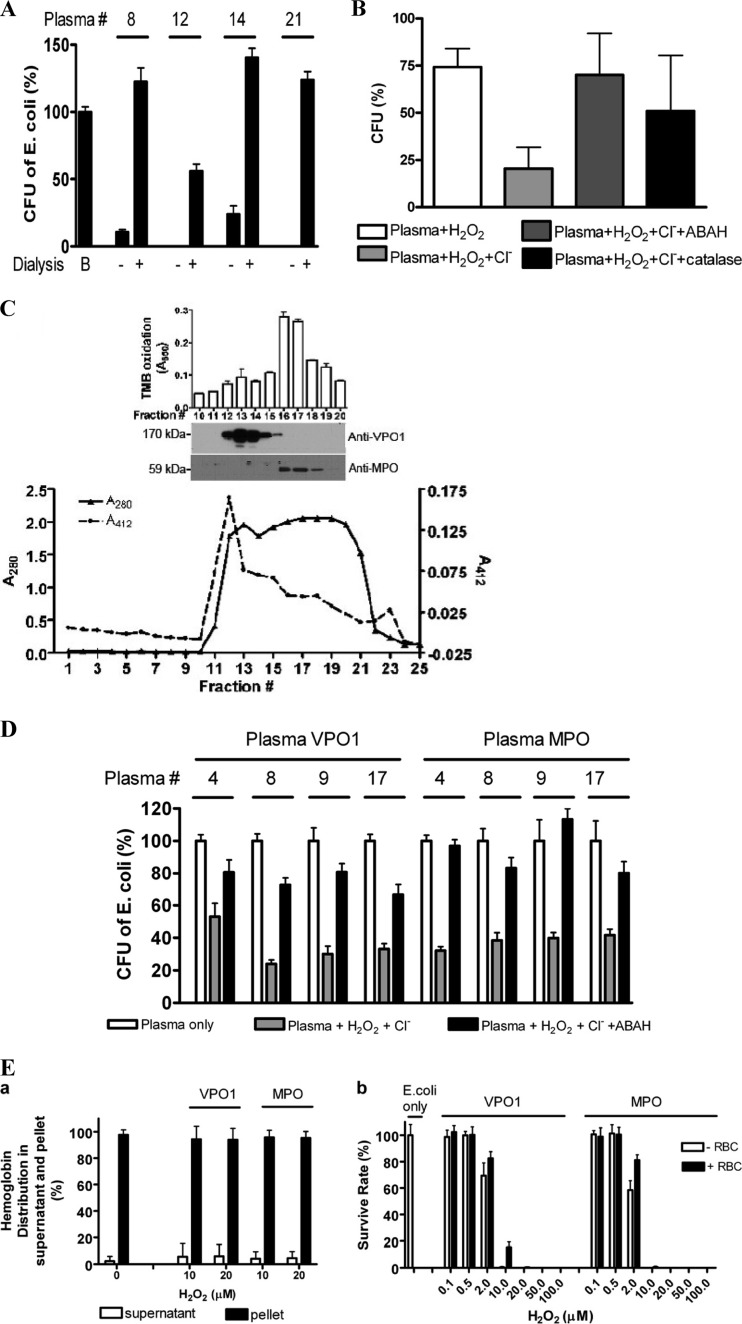Fig 5.
Bactericidal activity of plasma VPO1 and MPO. (A) Effect of dialysis on bactericidal activity of plasma. E. coli was incubated in 100 μl of 20 mM phosphate buffer (pH 7.2) containing 5 μl of plasma or dialyzed plasma at 37°C for 2 h. The cell mixtures were plated on LB plates. In control experiment B, the mixture contained only E. coli. The numbers are the plasma sample identifications. The data are representative of a minimum of three independent experiments for each group. (B) Bactericidal activity of plasma peroxidases. E. coli was incubated in 100 μl of 20 mM phosphate buffer (pH 7.2) containing 10 μl of dialyzed plasma sample each from 19 unrelated healthy individuals, H2O2 (10 μM), NaCl (140 mM), ABAH (500 μM), and 50 μg of catalase/ml as indicated at 37°C for 2 h. The cell mixtures were plated on LB plates and incubated at 37°C overnight. The colonies were counted, and the data are expressed as the percentages of colonies compared to the number seen with plasma plus E. coli alone. The data are representative of two independent experiments (n = 6) (means ± the SD). (C) Separation of plasma VPO1 from MPO. Portions (3 ml) of human plasma were loaded onto a Sephacryl S-300 column (1 by 110 cm) and eluted with phosphate buffer (pH 7.2). The eluent was collected (4 ml/tube), and the absorbance at 280 and 412 nm was monitored. The peroxidase activity of eluted fractions 10 to 20 was measured using TMB oxidation (inset). Fractions 10 to 20 were also subjected to analysis by SDS-PAGE and immunoblotting with antibodies against VPO1 and MPO (inset). These data are representative of at least three separations using different plasma samples. (D) Four human plasma samples were individually subjected to fractionation as described for panel C. The eluents with the strongest peroxidase activity (fractions 13 and 16 for VPO1 and MPO, respectively) were concentrated 10-fold to facilitate bacterial killing experiments. E. coli killing was carried out as described for panel B, except that 20 μl of fractionated plasma containing either VPO1 or MPO was added. The final concentrations of VPO1 and MPO were ca. 50% of that in native plasma. The numbers are plasma sample identifications. The data are representative of three independent experiments. Error bars indicate the SD. (E) VPO1-mediated bactericidal activity in the presence of RBCs. (a) Effects of VPO1 or MPO/H2O2/Cl− systems on RBCs. A total of 107 RBCs were incubated with 140 mM NaCl, 10 or 20 μM H2O2, and either 200 mM VPO1 or 50 nM MPO at 37°C for 1 h. Hemoglobin was determined by measuring the A415 of the supernatant and pellet, and the percentage of distribution was calculated using the A415 divided by the total A415 of the supernatant plus the pellet. (b) E. coli cells were incubated in 100 μl of 50 mM phosphate buffer (pH 6.2) containing 140 mM NaCl, the indicated amounts of H2O2, and either 200 nM rVPO1 or 50 nM MPO in the presence or absence of 107 RBCs at 37°C for 1 h. The cell mixtures were plated on LB agar plates, followed by incubation at 37°C overnight. The percentages of the CFU in the experimental group compared to the control group (E. coli only) were calculated.

